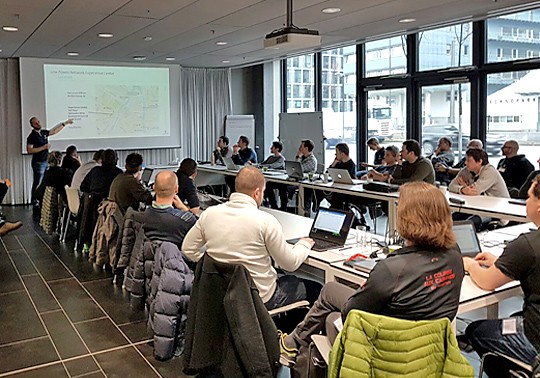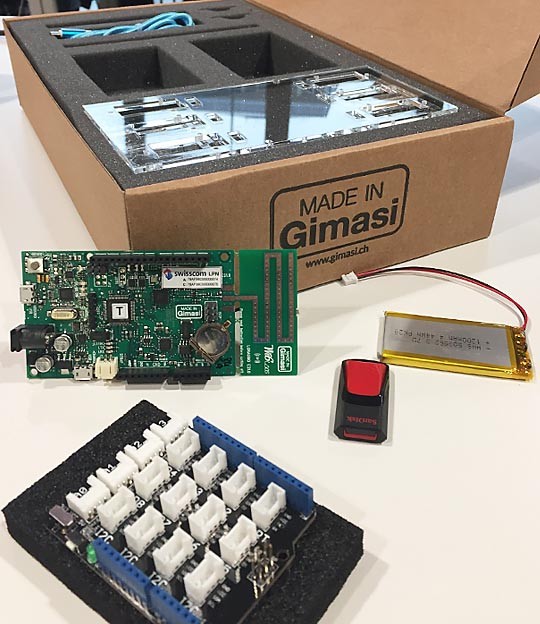Coaching for the “Low Power Network”
A boot camp for the Internet of Things
The participants at Swisscom’s LPN boot camps experimented with such things as a “swarm electrical network” and worldwide machine monitoring.
Texts: Urs Binder,
Both workshops were fully booked and there wasn't a free seat in the house: On 7 and 8 February, around 25 participants for each of the “LPN boot camps” arrived at the Swisscom building at Pfingstweidstrasse in Zurich. The abbreviation stands for “Low Power Network”, which specifically refers to the LoRaWAN technology. In the theoretical part of the course in the morning, the participants received basic technical knowledge, which they were then able to put into practice in the afternoon. To this end, everyone received an “LPN Maker’s Kit” with an Arduino-compatible development board, various sensors and actuators, and all necessary accessories to enter the world of LoRaWAN.
First steps
Swisscom operates a network of LoRaWAN base stations across Switzerland that can be used to connect sensors and other devices within the Internet of Things in a power-saving manner and across long distances, and to exchange data from users’ systems. And that was precisely the topic of the boot camp: How do you add an IoT device to the LoRaWAN network (onboarding)? How do you send messages and how do you receive messages from the network? Which types of projects can be implemented well with this technology, and which projects are better suited to other wireless technologies? What are the specific advantages and disadvantages of LoRaWAN as a comparison? And what particularities and costs apply to Swisscom’s network?
Taking their first steps into LoRaWAN was the most important issue for most participants, as specific projects are still a rarity. This does not apply to Elektron AG, as Product Manager Marc Länzlinger explains: “IoT and LoRa have long been a central issue for Elektron. We have offered networked public lighting with centralised control over IoT for many years, and we are now expanding this into full smart city solutions. One option for this is LoRaWAN, but we also use other IoT networks such as the IP-based Mesh 6loWPAN.”

Wide field of participants: the LPN boot camp included teachers, developers and engineers, among others.
Michael Albrecht, ICT Manager at Otto Suhner AG, is participating in the boot camp along with Suhner’s CTO. “We would like to find out what the advantages of LoRaWAN are, all the things it can be used for, what it costs and whether the technology is suited to our company.” There are some application ideas already: “We imagine that we could monitor our machines around the world using IoT in order to optimise usage and efficiency.”
A look at the list of participants demonstrates wide interest in LoRaWAN in various industries, from IoT-focused solution providers to logistics and financial services providers and manufacturers of small solar storage plants, who can form autonomous “swarm electrical networks”. An IT teacher from the canton of Jura, a developer and a network engineer from information services for the city of Winterthur and various researchers and students from the ETH completed the group.

The “LPN Maker’s Kit” with a development board, sensors and all necessary accessories to enter the world of LoRaWAN.
Detailed explanation
As is so often the case, with LoRaWAN the devil is in the detail. For onboarding, for example, various URLs and keys are required. LoRaWAN generally works bidirectionally, but depending on the device class, the connected devices remain available to receive only very briefly for energy saving reasons. This also places a great demand on the response time of the backend systems, for example the users’ application servers.
The boot camp participants received expert support from LPN specialists who work at the IoT-focused supplier Actility – whose platforms are also used by Swisscom’s LoRaWAN network –, from the Ticino-based digitisation specialist Gimasi, who put together the LPN Maker’s Kit, and from the Swisscom experts Nico Vonau and Adrian Fuchs.
LPN remains a hot issue
You can find more information about the next boot camps and LPN in general on the Swisscom LPN web page.
“Today, we can take measurements much more cheaply and simply and branch out into applications for which existing systems were too expensive or too difficult to realise.”
Justin D’Atri, Partnership Coordinator at Innet AG.
Justin D’Atri, Partnership Coordinator at the Swiss domestic environmental monitoring company Innet AG, was able to benefit immediately from the collective expert knowledge present: One problem with a LoRaWAN-networked distance sensor when it is used as a “smart waste sensor” to measure the fill level of waste containers to help route optimisation was solved at the boot camp.

Justin D’Atri, Partnership Coordinator at Innet AG
D’Atri was impressed by the new options: “We were building sensor networks before the “cool” term IoT was coined. The devices used to be much bigger – most people will be familiar with the air quality measuring stations alongside motorways. Some of them are the size of fridges! Today’s sensors are smaller; comparable devices could fit into the palm of your hand.” Thanks to new wireless technologies such as LoRaWAN, battery-powered devices also have a long period of autonomy, he continues, going on to mention that wireless networking also offers direct financial benefits: “The most expensive part is wiring up a sensor. Today, we can take measurements much more cheaply and simply and branch out into applications for which existing systems were too expensive or too difficult to realise.”
LPN Experience Center
The LPN Experience Center at the Swisscom office in Müllerstrasse 16 in Zurich is dedicated entirely to the Low Power Network. SME and enterprise business customers can register for a guided tour. Interesting live demos and insights into many fascinating potential applications await. Interested? Contact Roger Kaspar.
More on the topic

